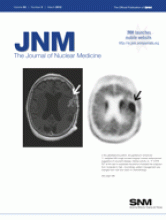Abstract
90Y radioembolization (selective internal radiation therapy [SIRT]) has emerged as a valuable therapeutic option in unresectable, chemotherapy-refractory hepatic metastases from breast cancer. The objective of the present study was to evaluate 18F-FDG PET/CT for predicting survival in these patients. Methods: Fifty-eight consecutive patients with hepatic metastases from breast cancer were treated with SIRT. Before therapy, all patients underwent MRI of the liver. 18F-FDG PET/CT was performed at baseline and 3 mo after SIRT to calculate percentage changes in maximum 18F-FDG standardized uptake value (SUVmax) relative to baseline. A decrease of more than 30% in the follow-up scan, compared with the baseline examination, indicated therapy response. Treatment response at 3 mo was also assessed in 43 patients using contrast-enhanced MRI and CT on the basis of the Response Evaluation Criteria in Solid Tumors. All patients were followed to complete survival data. Results: Overall median survival after SIRT was 47 wk. Response as assessed with SUVmax correlated significantly with survival after radioembolization, with responders having significantly longer survival (65 wk) than nonresponders (43 wk; P < 0.05). In multivariate analysis the change in SUVmax was identified as the only independent predictor of survival (hazard ratio, 0.23; P < 0.005). Furthermore, a high pretherapeutic SUVmax (>20) was associated with a significantly shorter median survival than was an SUVmax of 20 or less (21 vs. 52 wk; P < 0.005). The presence of extrahepatic metastases (mean survival in both groups, 47 wk; P = 0.92), hormone receptor status (estrogen, P = 0.53; progesterone, P = 0.79; Her-2/neu, P = 0.49), and MRI/CT response (P = 0.91) did not predict survival. Conclusion: The change in SUVmax as assessed by 18F-FDG PET/CT before and 3 mo after SIRT was identified as the only independent predictor of survival in patients with hepatic metastases of breast cancer.
Footnotes
Published online Feb. 13, 2012.
- © 2012 by the Society of Nuclear Medicine, Inc.







